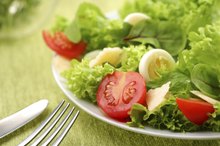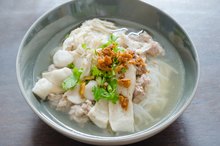Jimmy the Greek Fast Food Nutrition
The goal at Jimmy the Greek is to serve customers healthy and delicious food that is also authentic to Greece. The restaurant advertises fresh ingredients in its food that is served fast-food style. Learning more about the nutritional facts of the dinners, salads, specialities and side items can help you make a wise decision when eating at Jimmy the Greek.
Dinners
Each of the dinners at Jimmy the Greek includes a small salad, rice and roasted potatoes. The Chicken Souvlaki Dinner contains 291 calories and 10 g of fat, making it one of your more nutritious choices. It also has 16 g of protein and is a good source of vitamin C. The Roast Lamb Dinner has 510 calories and 30 g of fat, but it offers 3 g of fiber and 27 g of protein. The Gyros Dinner is a popular menu item and has 400 calories, 24 g of fat and 3 g of fiber. The Gyros are also a good source of iron.
- Each of the dinners at Jimmy the Greek includes a small salad, rice and roasted potatoes.
- The Gyros Dinner is a popular menu item and has 400 calories, 24 g of fat and 3 g of fiber.
Salads
Hooters Nutritional Guide
Learn More
The salad nutrition information does not include any salad dressing. The Large Salad has 152 calories and 6.5 g of fat. It contains 66 percent of your daily vitamin A requirements and 45 percent of the vitamin C you need. The Chicken Fillet has 314 calories, 12 g of fat and plenty of vitamin A and C. The Roast Lamb is the least healthy salad, with 752 calories and 53 g of fat, 16.5 g of them saturated. The Greek Salad Dressing adds 214 calories, 24 g of fat and 900 mg of sodium to any salad you order.
- The salad nutrition information does not include any salad dressing.
- The Chicken Fillet has 314 calories, 12 g of fat and plenty of vitamin A and C. The Roast Lamb is the least healthy salad, with 752 calories and 53 g of fat, 16.5 g of them saturated.
Specialties
The Specialties menu offers additional options that come with pita rather than rice and potatoes. The Pork Souvlaki with Pita has 372 calories and 8.5 g of fat, making it a healthy choice. The Gyros with Pita have 540 calories and 36.5 g of fat, as well as 1,040 mg of sodium per serving. The Spinach Cheese Pie is quite popular, with 223 calories and 14 g of fat. The spinach adds vitamins A and C to your meal. The lowest fat and calorie choice is the Shrimp Griller for 77 calories and 5 g of fat. The shrimp also supplies 8 g of protein.
- The Specialties menu offers additional options that come with pita rather than rice and potatoes.
- The Pork Souvlaki with Pita has 372 calories and 8.5 g of fat, making it a healthy choice.
Side Dishes and Extras
How to Eat Healthy at White Castle
Learn More
The dinners come with sides, but you may want to add something to your salad or specialty choice. The Oven Baked Rice has 201 calories, 4 g of fat and 318 mg of sodium. The Oven Roasted Potatoes are a good source of fiber and have 168 calories and 6.5 g of fat in each serving. A pita has 210 calories, 2.5 g of fat and 350 mg of sodium. The pitas are a good source of iron, as well. The baklava is the only dessert on the menu and will add 140 calories and 9 g of fat to the rest of your meal.
- The dinners come with sides, but you may want to add something to your salad or specialty choice.
- The Oven Roasted Potatoes are a good source of fiber and have 168 calories and 6.5 g of fat in each serving.
Considerations
Dana Facaros and Linda Theodorou, authors of "Greece" note that eating a Greek diet can be quite healthy when you choose the right ingredients and methods of preparation 1. Meats, rice and vegetables are important parts of a well-balanced and healthy diet, and Jimmy the Greek offers them on the menu. Sodium is one concern at the restaurant because many of the sauces used contain a great deal of salt. Order the sauce on the side to help to decrease your sodium intake.
- Dana Facaros and Linda Theodorou, authors of "Greece" note that eating a Greek diet can be quite healthy when you choose the right ingredients and methods of preparation 1.
- Sodium is one concern at the restaurant because many of the sauces used contain a great deal of salt.
Related Articles
References
- "Greece"; Dana Facaros and Linda Theodorou; 2003
Writer Bio
Sara Ipatenco has taught writing, health and nutrition. She started writing in 2007 and has been published in Teaching Tolerance magazine. Ipatenco holds a bachelor's degree and a master's degree in education, both from the University of Denver.









